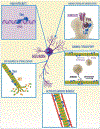It's all about tau
- PMID: 30605723
- PMCID: PMC6397676
- DOI: 10.1016/j.pneurobio.2018.12.005
It's all about tau
Abstract
Tau is a protein that is highly enriched in neurons and was originally defined by its ability to bind and stabilize microtubules. However, it is now becoming evident that the functions of tau extend beyond its ability to modulate microtubule dynamics. Tau plays a role in mediating axonal transport, synaptic structure and function, and neuronal signaling pathways. Although tau plays important physiological roles in neurons, its involvement in neurodegenerative diseases, and most prominently in the pathogenesis of Alzheimer disease (AD), has directed the majority of tau studies. However, a thorough knowledge of the physiological functions of tau and its post-translational modifications under normal conditions are necessary to provide the foundation for understanding its role in pathological settings. In this review, we will focus on human tau, summarizing tau structure and organization, as well as its posttranslational modifications associated with physiological processes. We will highlight possible mechanisms involved in mediating the turnover of tau and finally discuss newly elucidated tau functions in a physiological context.
Keywords: Axonal transport; Dendrites; Microtubules; Posttranslational modifications; Tau.
Copyright © 2018 Elsevier Ltd. All rights reserved.
Conflict of interest statement
11. CONFLICT OF INTERERST
The authors declare not conflict of interest regarding this work
Figures



Similar articles
-
Tau phosphorylation in neuronal cell function and dysfunction.J Cell Sci. 2004 Nov 15;117(Pt 24):5721-9. doi: 10.1242/jcs.01558. J Cell Sci. 2004. PMID: 15537830 Review.
-
Role of tau protein in both physiological and pathological conditions.Physiol Rev. 2004 Apr;84(2):361-84. doi: 10.1152/physrev.00024.2003. Physiol Rev. 2004. PMID: 15044677 Review.
-
Why kiss-and-hop explains that tau does not stabilize microtubules and does not interfere with axonal transport (at physiological conditions).Cytoskeleton (Hoboken). 2024 Jan;81(1):47-52. doi: 10.1002/cm.21787. Epub 2023 Sep 11. Cytoskeleton (Hoboken). 2024. PMID: 37694806
-
Hyperphosphorylation of Tau Associates With Changes in Its Function Beyond Microtubule Stability.Front Cell Neurosci. 2018 Oct 9;12:338. doi: 10.3389/fncel.2018.00338. eCollection 2018. Front Cell Neurosci. 2018. PMID: 30356756 Free PMC article. Review.
-
Normal and pathological Tau proteins as factors for microtubule assembly.Int Rev Cytol. 1997;171:167-224. doi: 10.1016/s0074-7696(08)62588-7. Int Rev Cytol. 1997. PMID: 9066128 Review.
Cited by
-
Linking Molecular Pathways and Large-Scale Computational Modeling to Assess Candidate Disease Mechanisms and Pharmacodynamics in Alzheimer's Disease.Front Comput Neurosci. 2019 Aug 13;13:54. doi: 10.3389/fncom.2019.00054. eCollection 2019. Front Comput Neurosci. 2019. PMID: 31456676 Free PMC article.
-
BAG3 regulates the specificity of the recognition of specific MAPT species by NBR1 and SQSTM1.Autophagy. 2024 Mar;20(3):577-589. doi: 10.1080/15548627.2023.2276622. Epub 2023 Nov 8. Autophagy. 2024. PMID: 37899687 Free PMC article.
-
Phosphorylation of Tau and α-Synuclein Induced Neurodegeneration in MPTP Mouse Model of Parkinson's Disease.Neuropsychiatr Dis Treat. 2020 Mar 4;16:651-663. doi: 10.2147/NDT.S235562. eCollection 2020. Neuropsychiatr Dis Treat. 2020. PMID: 32184604 Free PMC article.
-
Altered Tau Kinase Activity in rTg4510 Mice after a Single Interfaced CHIMERA Traumatic Brain Injury.Int J Mol Sci. 2023 May 29;24(11):9439. doi: 10.3390/ijms24119439. Int J Mol Sci. 2023. PMID: 37298388 Free PMC article.
-
The Functions and Phenotypes of Microglia in Alzheimer's Disease.Cells. 2023 Apr 21;12(8):1207. doi: 10.3390/cells12081207. Cells. 2023. PMID: 37190116 Free PMC article. Review.
References
-
- Alonso Adel C, Mederlyova A, Novak M, Grundke-Iqbal I, and Iqbal K (2004). Promotion of hyperphosphorylation by frontotemporal dementia tau mutations. J Biol Chem 279, 34873–34881. - PubMed
-
- Andreadis A (2005). Tau gene alternative splicing: expression patterns, regulation and modulation of function in normal brain and neurodegenerative diseases. Biochim Biophys Acta 1739, 91–103. - PubMed
-
- Andreadis A, Brown WM, and Kosik KS (1992). Structure and novel exons of the human tau gene. Biochemistry 31, 10626–10633. - PubMed
-
- Arai T, Guo JP, and McGeer PL (2005). Proteolysis of non-phosphorylated and phosphorylated tau by thrombin. J Biol Chem 280, 5145–5153. - PubMed
Publication types
MeSH terms
Substances
Grants and funding
LinkOut - more resources
Full Text Sources

